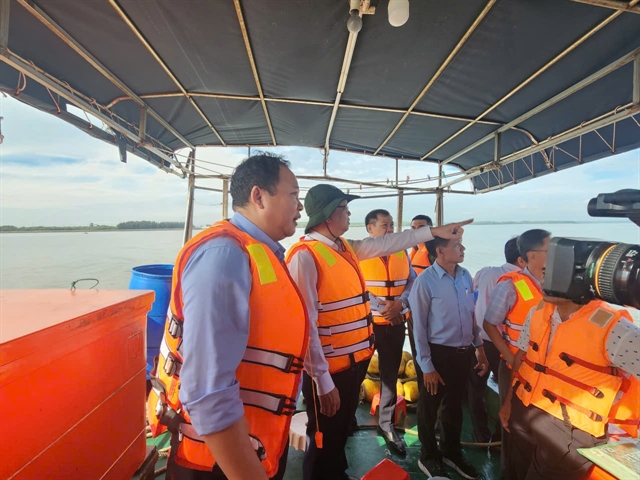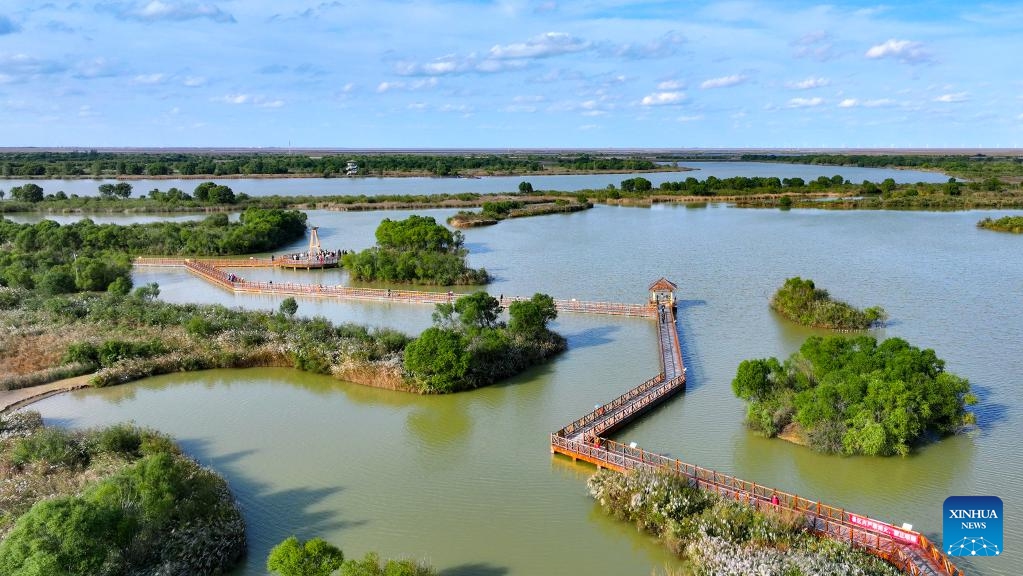HCM City steps up efforts to rid EU ‘yellow card’ for illegal, unreported and unregulated fishing – vietnamnews.vn

Report on Ho Chi Minh City’s Enhanced Measures Against IUU Fishing
Introduction: Aligning with Sustainable Development Goals to Combat IUU Fishing
In a critical phase of Việt Nam’s national effort to have the European Commission’s “yellow card” warning lifted, Ho Chi Minh City is intensifying its measures against illegal, unreported, and unregulated (IUU) fishing. This initiative is framed as a direct contribution to achieving the United Nations’ Sustainable Development Goals (SDGs), particularly SDG 14 (Life Below Water), which calls for the conservation and sustainable use of marine resources. The city’s strategy integrates stricter oversight, advanced monitoring, and severe penalties to foster a responsible and sustainable marine economy.
Strategic Governance and Enforcement Framework
Policy and Enforcement for SDG 16: Peace, Justice, and Strong Institutions
The Ho Chi Minh City People’s Committee has mandated a zero-tolerance policy towards negligence in the management of fishing activities. This approach strengthens maritime law enforcement and builds accountable institutions, in line with SDG 16. Key enforcement directives include:
- Immediate detention of any vessel found at sea without a valid licence.
- Consideration of criminal proceedings for unlicensed vessels found carrying fishing equipment or aquatic products.
- Severe penalties for vessels that lose Vessel Monitoring System (VMS) connection without a valid reason.
These measures are designed to ensure that all fishing operations are lawful, transparent, and compliant with national and international regulations.
Vessel Monitoring and Compliance: A Commitment to SDG 14
The city’s primary operational goal is to achieve 100% registration and VMS equipment installation for its fishing fleet. This directly addresses SDG Target 14.4, which aims to end IUU fishing and destructive fishing practices. To achieve this, local authorities have been instructed to implement several measures:
- Consolidate all vessels at designated points for easier management.
- Install public monitoring boards and surveillance cameras where necessary.
- Engage local communities to act as supervisory partners in reporting violations.
Operational Status and Current Challenges
Fleet Management and Data Integrity
According to the Department of Agriculture and Rural Development, the city’s fishing fleet, based in the coastal Cần Giờ District, shows high but incomplete compliance. Current statistics indicate:
- 98% of the fleet holds valid fishing licences.
- 2% of licences have been temporarily suspended.
- Approximately 329 vessels still do not meet licensing requirements.
To improve data accuracy for effective management under SDG 14, authorities are actively deregistering old, damaged, and inactive vessels from the city’s fisheries database.
Monitoring and Surveillance Report
Since the beginning of the year, 789 instances of vessels losing VMS signals have been recorded. Between October 25 and 31, ten suspected violations were detected; these vessels are under investigation pending their return to port. To mitigate risks, enhanced early-warning systems are in place to detect and prevent potential encroachment into foreign waters by licensed vessels.
Building a Sustainable and Responsible Seafood Supply Chain
Enhancing Traceability for SDG 12: Responsible Consumption and Production
A significant focus has been placed on strengthening the oversight of seafood purchasing and distribution to ensure a fully traceable supply chain. This commitment aligns with SDG 12 by promoting sustainable production and consumption patterns. Businesses, traders, and fishermen are required to adhere strictly to documentation protocols that verify the legal and traceable origins of all seafood catches.
Economic Viability and Livelihoods: The Core of SDG 8 and SDG 14
The city’s seafood industry, valued at an estimated VNĐ 5.8 trillion (US$227 million) in 2024, is a cornerstone of the local economy. Securing its long-term viability through sustainable practices supports SDG 8 (Decent Work and Economic Growth). Lifting the “yellow card” is essential for protecting export markets, especially the European Union, which constitutes approximately 15% of the city’s seafood exports. Officials emphasize that compliance with IUU regulations protects not only marine resources but also the livelihoods of fishermen.
Capacity Building and Stakeholder Engagement
Infrastructure and Community Partnerships for SDG 17
In line with SDG 17 (Partnerships for the Goals), Ho Chi Minh City has fostered a multi-stakeholder approach by investing in infrastructure and engaging the community. Key initiatives include:
- Modernising fisheries management with satellite-based monitoring systems and digitalised vessel databases.
- Providing financial assistance to fishermen for VMS installation.
- Conducting regular training sessions on legal and sustainable fishing practices.
- Supporting community-based fisheries management models to empower local stakeholders in the protection of marine ecosystems.
Conclusion: A Comprehensive Vision for a Sustainable Marine Economy
Ho Chi Minh City’s fight against IUU fishing is a comprehensive strategy aimed at building a transparent, accountable, and environmentally responsible marine economy. The objective extends beyond the removal of the “yellow card” to reflect a fundamental commitment to the Sustainable Development Goals. By enforcing robust regulations and fostering a culture of compliance, the city aims to safeguard marine biodiversity, secure economic prosperity, and solidify Việt Nam’s reputation as a sustainable seafood producer on the global stage.
Analysis of Sustainable Development Goals in the Article
1. Which SDGs are addressed or connected to the issues highlighted in the article?
- SDG 14: Life Below Water: This is the primary SDG addressed. The article focuses extensively on combating illegal, unreported, and unregulated (IUU) fishing, promoting sustainable fishing practices, protecting marine resources, and managing fisheries to ensure the health of marine ecosystems.
- SDG 8: Decent Work and Economic Growth: The article connects sustainable fishing directly to economic stability and growth. It highlights that these measures protect the livelihoods of fishermen and the nation’s reputation in the global seafood market, which is crucial for economic activities like exports. The city’s seafood industry is valued at VNĐ 5.8 trillion (US$227 million).
- SDG 12: Responsible Consumption and Production: The emphasis on seafood traceability, ensuring catches do not have untraceable origins, and building a transparent supply chain directly relates to sustainable production patterns. The goal is to create a “responsible marine economy.”
- SDG 17: Partnerships for the Goals: The entire context of lifting the European Commission’s “yellow card” represents an interaction between a national entity (Việt Nam) and an international body (the EU) to achieve global standards for sustainable development. It also implies partnerships between government, local communities, and businesses to enforce regulations.
2. What specific targets under those SDGs can be identified based on the article’s content?
-
Under SDG 14 (Life Below Water):
- Target 14.4: “By 2020, effectively regulate harvesting and end overfishing, illegal, unreported and unregulated fishing and destructive fishing practices…” The article’s central theme is the effort to combat IUU fishing through stricter vessel management, monitoring via Vessel Monitoring Systems (VMS), and imposing severe penalties for violations.
- Target 14.7: “By 2030, increase the economic benefits to Small Island developing States and least developed countries from the sustainable use of marine resources…” The article explicitly states that lifting the “yellow card” is vital for protecting export markets, particularly the EU, which accounts for 15% of the city’s seafood exports. This directly links sustainable management of fisheries to economic benefits.
- Target 14.c: “Enhance the conservation and sustainable use of oceans and their resources by implementing international law…” The effort to comply with the European Commission’s regulations is a direct application of this target, as it involves adhering to international standards for fishing to ensure sustainable use of marine resources.
-
Under SDG 8 (Decent Work and Economic Growth):
- Target 8.4: “Improve progressively, through 2030, global resource efficiency in consumption and production and endeavour to decouple economic growth from environmental degradation…” The article describes the city’s aim to “build a responsible marine economy that safeguards livelihoods, protects marine biodiversity,” which is a clear attempt to ensure economic activity (the VNĐ 5.8 trillion seafood industry) does not lead to the degradation of marine resources.
-
Under SDG 12 (Responsible Consumption and Production):
- Target 12.2: “By 2030, achieve the sustainable management and efficient use of natural resources.” The entire strategy of vessel registration, monitoring, licensing, and traceability is aimed at the sustainable management of marine fish stocks.
3. Are there any indicators mentioned or implied in the article that can be used to measure progress towards the identified targets?
- Yes, the article mentions several specific quantitative and qualitative indicators that can be used to measure progress.
-
For Target 14.4 (End IUU Fishing):
- Percentage of fishing vessels registered: The article states a goal of “100 per cent of fishing vessels to be registered” and notes that currently “98 per cent of the city’s fishing fleet… has valid fishing licences.”
- Percentage of fishing vessels with VMS: The goal is for 100% of vessels to be “equipped with vessel monitoring systems.”
- Number of VMS signal loss incidents: The article reports that “authorities have recorded 789 cases of vessels losing VMS signals” since the start of the year, which serves as a metric for non-compliance.
- Number of non-compliant vessels: The text mentions that “329 fishing vessels still fail to meet licensing requirements,” providing a clear number to track.
-
For Target 14.7 (Economic Benefits):
- Total value of the seafood industry: The article provides a specific figure: “an estimated VNĐ 5.8 trillion (US$227 million) in 2024.”
- Share of exports to key markets: The article indicates that the European Union “accounts for about 15 per cent of the city’s seafood exports,” a key metric for market access.
-
For Target 12.2 (Sustainable Management):
- Implementation of traceability systems: Progress can be measured by the enforcement of “documentation requirements for seafood traceability” and oversight to prevent the sale of “catches lacking traceable origins.”
Summary of SDGs, Targets, and Indicators
| SDGs | Targets | Indicators |
|---|---|---|
| SDG 14: Life Below Water | 14.4: End illegal, unreported and unregulated (IUU) fishing and implement science-based management plans. |
|
| 14.7: Increase economic benefits from the sustainable use of marine resources. |
|
|
| 14.c: Implement international law for the conservation and sustainable use of oceans. |
|
|
| SDG 8: Decent Work and Economic Growth | 8.4: Decouple economic growth from environmental degradation. |
|
| SDG 12: Responsible Consumption and Production | 12.2: Achieve the sustainable management and efficient use of natural resources. |
|
Source: vietnamnews.vn
What is Your Reaction?
 Like
0
Like
0
 Dislike
0
Dislike
0
 Love
0
Love
0
 Funny
0
Funny
0
 Angry
0
Angry
0
 Sad
0
Sad
0
 Wow
0
Wow
0
















































:focal(1500,1000)/https://media.globalcitizen.org/a6/9a/a69a4720-d8a1-4715-b596-18738d03c05c/rotary_polio_hero_image.jpg?#)







/countries/sri-lanka/photo-credit---dmc-sri-lanka.tmb-1200v.jpg?sfvrsn=dc298bcc_1#)

















